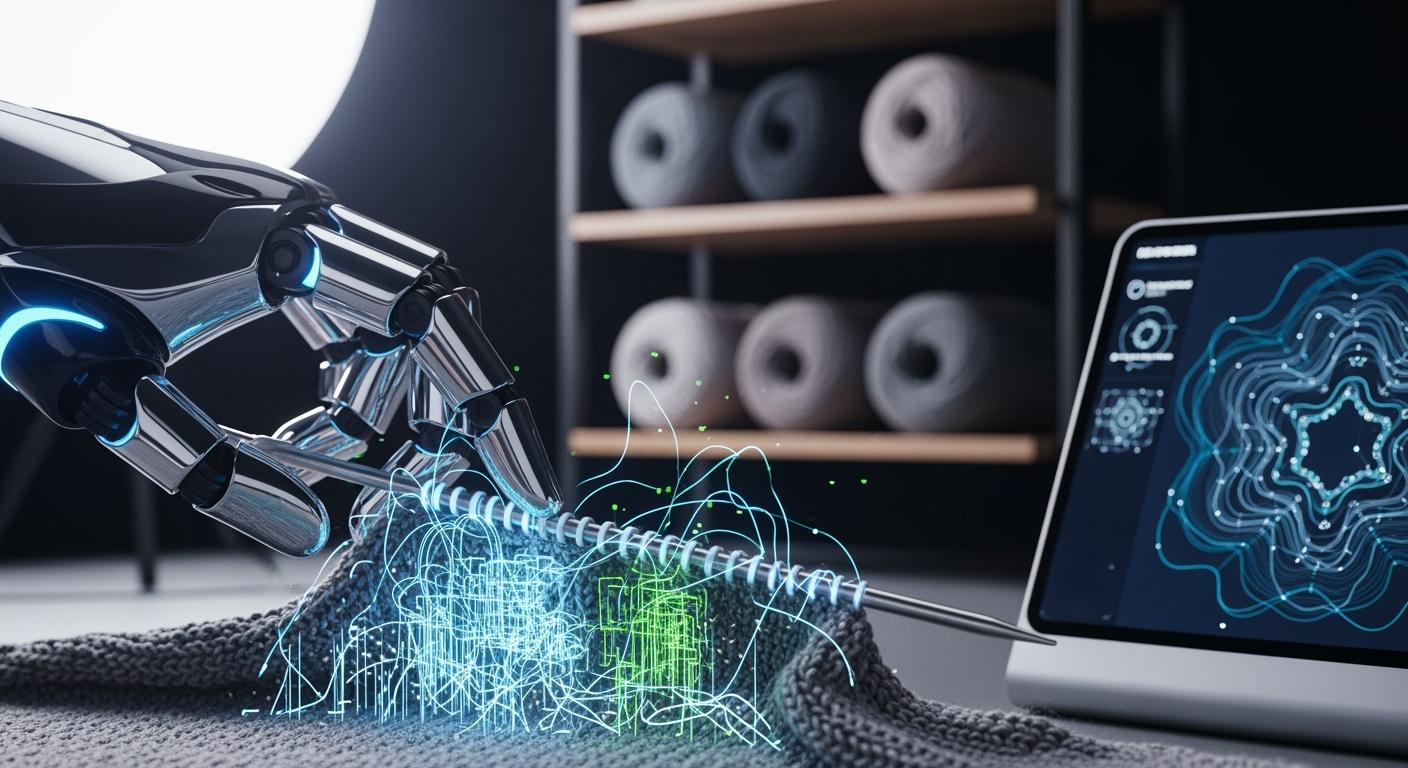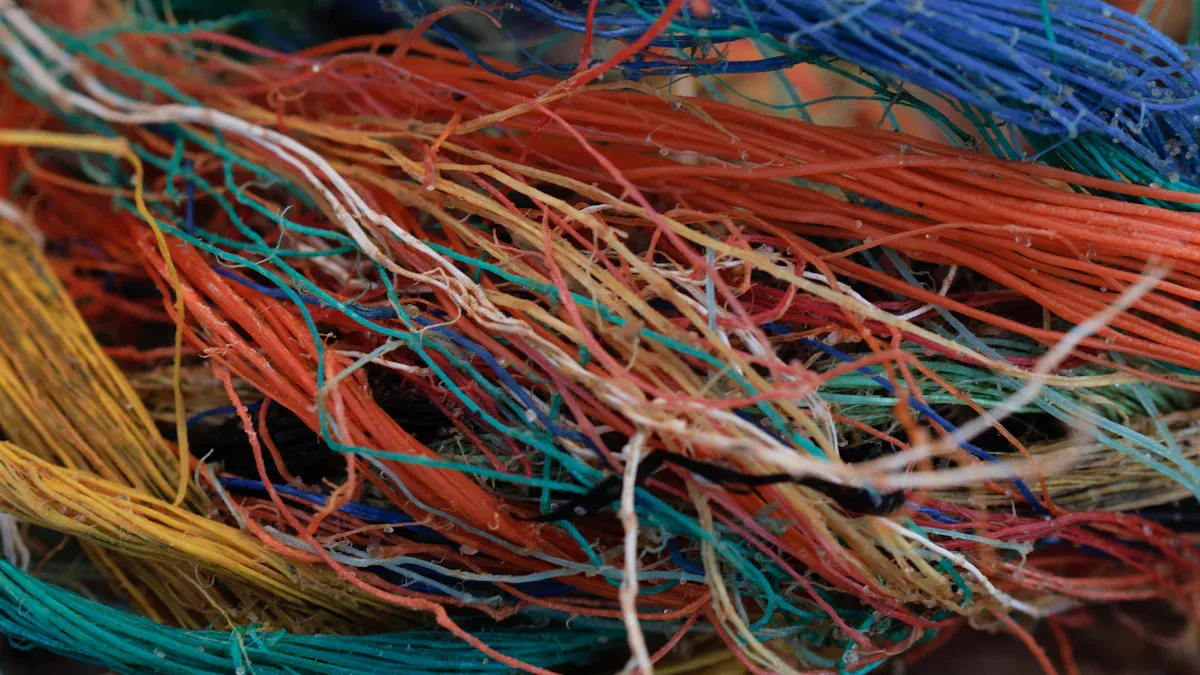
Traditional knitting is a careful, manual craft. Today, artificial intelligence is making it a high-tech industry. This AI revolutionizes knitting. The global knitwear market is growing fast. AI is a key part of this growth.
| Metric | Value |
|---|---|
| Global Knitwear Market Size (2024) | USD 907.60 billion |
| Projected Market Size (2032) | USD 2263.28 billion |
| CAGR (2025-2032) | 12.10% |
AI is changing the entire lifecycle of knitting. The technology impacts everything from initial design to final textile production. This AI-assisted knitwear design process uses AI to improve manufacturing. This is the future of knitting.
The Dawn of AI-Assisted Knitwear Design

Artificial intelligence is now a creative partner in the design studio. It helps designers explore new ideas for knitting. This AI-assisted knitwear design process starts long before any yarn is touched. AI technologies give designers powerful tools. These tools speed up creativity and improve the entire workflow. The result is an innovative and efficient approach to textile production.
Generative AI for Pattern Inspiration
Designers often face creative blocks. AI helps them overcome these challenges. An AI can generate endless visual concepts from simple text prompts. This process gives designers a starting point for new collections. The AI-driven design approach allows for rapid exploration of colors, textures, and shapes. Fashion brand Unmade already uses generative design for its customizable knitwear. Its system lets customers change a base design. Then, AI creates the technical instructions for knitting the unique garment.
Several platforms now specialize in AI-generated patterns for textiles. These tools are becoming essential for modern designers.
- Weaver AI
- FabricGenie
- PatternedAI
- Pietra AI fabric pattern changer
AI also helps visualize complex knitting structures. An AI can create detailed, stitch-by-stitch animations of difficult techniques like cables and lace. These animations show how the yarn and needles move. This clarity is hard to achieve with traditional diagrams or videos. The AI can even suggest the best camera angles to highlight critical steps in the knitting process. This makes complex knitting patterns easier to understand and execute.
Virtual Prototyping to Reduce Waste
The fashion industry has a major waste problem. Creating physical samples uses a lot of resources. Virtual prototyping offers a powerful solution. This method uses 3D modeling to create digital garments. Designers can see how a sweater will drape, fit, and move without making a physical object. This digital process is a key part of ai-assisted knitwear design.
Software platforms are at the center of this change.
- Browzwear uses AI for realistic garment visualization, especially for knitted fabrics.
- Style3D has an AI tool that creates realistic fabric textures from text descriptions.
These tools help designers make decisions digitally. They can test different yarns and fits on a virtual model. This process leads to significant waste reduction. Advanced virtual prototyping can cut material use by up to 48%. This means fewer physical samples are needed. The entire design cycle becomes faster and more cost-effective.
Reducing physical samples directly lowers the industry's environmental footprint. Less sampling means less discarded material and lower costs. It is a major step toward a sustainable future for textile production.
Morgan Stanley analysts noted in a May 2022 report that 'The apparel industry uses enough fresh water to quench the thirst of five million people a year, produces 20 percent of global wastewater, and has a carbon intensity that exceeds aviation and shipping combined.'
Virtual prototyping addresses these issues directly. It reduces the environmental impact of the design phase. The table below compares the traditional method to the virtual one.
| Environmental Impact | Traditional Method | Virtual Prototyping |
|---|---|---|
| Water Consumption | Uses massive amounts of fresh water. | Significantly reduced with fewer physical samples. |
| Carbon Intensity | Exceeds aviation and shipping combined. | Lowered by reducing shipping and sample manufacturing. |
| Textile Waste | 85% of clothing ends up in landfills. | Dramatically reduces fabric waste from samples. |
This shift in the design process shows how AI is making the knitting industry smarter and more responsible.
From Digital Design to Machine Code
A beautiful design is only the first step. The next challenge is translating that creative vision into a language that industrial machines can understand. This is where AI acts as a critical translator. It converts complex visual data into precise, line-by-line machine code. This automation is a huge leap forward for textile production. It removes a major bottleneck in the journey from concept to final garment. The process ensures that the final product matches the designer's original intent with perfect accuracy.
Decoding Images into Knit Instructions
Turning a simple image into a complete set of knitting instructions was once a manual, time-consuming task. Now, AI can reverse-engineer a fabric's structure directly from a picture. This technology is a core part of ai-assisted knitwear design. The AI analyzes a 2D image of a knit pattern. It then generates the machine-readable code needed for production. This capability accelerates development and opens new creative pathways for knitting.
Researchers have developed powerful AI systems to solve this complex problem. These systems learn to generate instructions from images.
- One approach uses a machine learning pipeline. The AI trains on a large dataset of synthetic images and their corresponding knitting instructions. It learns to create correct instructions for real fabric images.
- Another method uses a deep learning system. This AI first processes a real image into a simplified, synthetic version. A special module then predicts basic knitting instructions. A second AI model uses these basic instructions to infer the complete, machine-ready code.
This technology allows designers to take a photograph of a vintage sweater or a unique texture and quickly get the code to replicate it. This advancement in robotics in knitting makes inspiration instantly manufacturable. The AI handles the technical translation, freeing the designer to focus on creativity. This is a key step in modernizing textile production.
Automated Technical Packet Generation
Every garment needs a detailed blueprint before it enters manufacturing. This blueprint is called a technical packet, or "tech pack." It contains all the essential information for the factory. Creating these documents manually is slow and prone to human error. AI introduces speed and precision to this critical stage. The AI can generate a complete tech pack in minutes from a design file. This automation streamlines the entire pre-production workflow.
What's in an AI-Generated Tech Pack? An AI-powered system pulls data directly from design files to create a comprehensive document. This ensures nothing is lost in translation. Key components include:
- Technical Sketches: Detailed front and back drawings showing all seams and design elements.
- Bill of Materials (BOM): A complete list of all fabrics, trims, zippers, buttons, and labels.
- Garment Measurements: A full list of measurement points and size specifications with tolerances.
- Construction Details: Specific instructions on seam types and stitches per inch.
- Colorways: Approved color codes for every component of the garment.
- Artwork and Labeling: Placement diagrams and material requirements for logos and care labels.
This level of automation offers huge benefits for textile production. Companies like Superlane.ai already offer this service. Their AI drafts tech packs with measurements and material lists directly from design files. This process dramatically reduces lead times and costs. The use of AI in robotics in knitting ensures every detail is correct.
The impact on efficiency is clear. AI-powered knitting machines and smart knitting machines rely on this perfect data. The automation of knitting instructions and tech packs is fundamental. It enables advanced systems like automated yarn feeding and other robotics in knitting. The result is a faster, more reliable path from design to the factory floor.
| Aspect | Benefit of AI Automation |
|---|---|
| Lead Time | Reduces tech pack creation from days to minutes. |
| Human Error | Minimizes mistakes by generating standardized, clear instructions. |
| Specification Generation | AI automatically extracts stitch types and measurements from models. |
| Material Suggestions | The AI can recommend the best materials for the design's needs. |
The Rise of AI-Driven Manufacturing
AI is transforming the factory floor. The technology moves from digital design to physical creation. This shift introduces a new era of ai-driven manufacturing. AI technologies bring intelligence directly to the production line. This automation enhances every step of the knitting process. The use of robotics in knitting is making factories smarter and more efficient. This change improves both quality and speed in textile production.
The Role of AI in Quality Control
Perfect quality is the goal of all manufacturing. AI helps factories achieve this goal with incredible precision. An automated quality control system uses computer vision to watch over the knitting process. High-resolution cameras scan the fabric in real time. The AI instantly detects problems like dropped stitches or yarn inconsistencies. This immediate feedback allows for quick corrections. A McKinsey report shows that AI can reduce overall defect rates by up to 50%. Early detection also improves the first-pass yield by up to 25%.
Several companies already use this technology for knitting and textile production. Their results show the power of AI.
| Manufacturer/Partner | AI Implementation | Results |
|---|---|---|
| EasyODM | Machine vision software | Detects 99% of wrinkle defects for flawless fabrics. |
| EverLighten | AI vision system for fabric and stitching | Achieved a 90% reduction in defective products. |
This level of AI-driven oversight ensures that every garment meets the highest standards. The integration of robotics in knitting is key to this success.
Predictive Maintenance and Efficiency
Industrial knitting machines are complex. Unexpected breakdowns cause major delays and costs. AI solves this problem with predictive maintenance. The AI analyzes data from machines to forecast failures before they happen. This process keeps the production line running smoothly. A factory using this AI approach saw a 40% decrease in unexpected machine breakdowns.
How AI Predicts Machine Failures AI systems use data to find patterns that signal a future problem.
- The AI learns from large volumes of real-time machine data.
- It uses machine learning to detect anomalies and predict part failures.
- The system can classify different types of machine stops with 92% accuracy, allowing for timely repairs.
Smart knitting machines also optimize energy use. The AI adjusts machine settings based on the fabric type and production volume. This reduces waste and lowers energy consumption by up to 25%. Ai-powered knitting machines with self-learning capabilities are central to modern robotics in knitting. This smart automation supports an efficient and sustainable ai-driven supply chain. The future of automated e-textile manufacturing and textile production depends on these intelligent systems. The robotics in knitting field is advancing quickly thanks to AI.
The Future: Sustainable and Personalized Knitwear

The future of knitwear is intelligent, sustainable, and personal. AI is pushing the industry toward a model that eliminates waste and empowers individual creativity. This shift promises a more responsible approach to textile production. The integration of AI also paves the way for advanced smart textiles. This new era of ai-assisted knitwear design focuses on efficiency and customization.
Zero-Waste and On-Demand Production
AI plays a vital role in creating a zero-waste manufacturing process. Whole-garment knitting already reduces waste by creating items in one piece. AI enhances this by optimizing fabric use. Smart algorithms arrange pattern pieces with incredible efficiency, reducing material waste by up to 20%. This automation makes zero-waste textile production a practical reality.
This efficiency enables on-demand production. Companies can now make garments only after a customer places an order. The company Unspun uses AI to create custom-fit jeans from a customer's 3D body scan. This on-demand production model completely removes the need for inventory. Major brands also use AI to analyze trends and create virtual samples, speeding up the process. This creates a more responsive and sustainable ai-driven supply chain. The development of smart textiles further supports this innovative approach to textile production.
Daniel Grieder, CEO of Tommy Hilfiger Global, stated, "The potential of 3D design is limitless, allowing us to meet consumer needs faster and in a more sustainable way."
Democratizing Design for Novices
AI is making knitting design accessible to everyone. New tools empower novices to create their own unique garments without needing technical skills. This enhanced customization puts creative power directly into the hands of consumers. The rise of smart textiles also offers new possibilities for personal projects. This digital customization is changing the face of hobbyist knitting.
User-friendly apps use AI to generate knitting patterns from simple ideas. This allows for real-time customization.
- purlJam is an app that uses AI to create unique knitting patterns.
- Users can type in an idea like 'striped beanie with two colors'.
- The AI instantly generates a personalized and unique design.
Other AI platforms simplify the entire process of creating a custom knitting pattern. They act as virtual instructors for beginners.
- The Knit Maker AI Engine generates complete instructions and visual guides.
- It offers a 3D designer for visualizing knitting patterns.
- The AI provides help on everything from basic concepts to advanced techniques.
This level of AI support removes barriers, making customization and design a reality for anyone interested in knitting.
Artificial intelligence is reinventing the knitwear industry from start to finish. The technology assists in creative design, automates machine instructions, and optimizes factory manufacturing. This shift enables sustainable textile production and deep customization. The future of knitting empowers both designers and consumers. This use of AI allows anyone to create unique, on-demand garments, heralding a new era for fashion.
FAQ
Will AI replace human knitwear designers?
No, AI will not replace human designers. 🤖 It acts as a creative partner. The technology automates technical tasks. This process frees designers to focus on innovation and new ideas. AI enhances creativity, it does not eliminate it.
Is AI knitwear technology only for big companies?
No, this technology is becoming more accessible. Many new software tools and apps offer affordable solutions. Small businesses and independent designers can now use AI. It helps them compete with larger brands by improving efficiency and creativity.
How does AI help with sustainability in knitting?
AI promotes sustainability in several ways. ♻️ Virtual prototyping reduces the need for physical samples. This saves materials and water. AI also optimizes pattern layouts for on-demand production. This process minimizes fabric waste and unsold inventory, creating a greener supply chain.
Key Takeaway: AI-driven manufacturing directly supports a more responsible and efficient fashion industry by cutting down on waste at multiple stages.
Can hobbyists use AI for their knitting projects?
Yes, hobbyists can use AI. New apps and platforms allow anyone to generate custom knitting patterns. Users can input simple ideas. The AI then creates unique designs and instructions. This makes custom design accessible to everyone, not just professionals.
See Also
Forecasting Textile Equipment Needs: AI-Driven Maintenance Strategies for 2025
Revolutionary AI in Fashion: Sustainable Solutions for an Improved Planet
Intelligent AI for Fashion: Optimizing Product Returns and Enhancing Efficiency
Transforming Traditional Apparel: Strategic Pathways from Production to Brand Identity
AI's Role in Fast Fashion: Managing and Adapting to Viral Trends